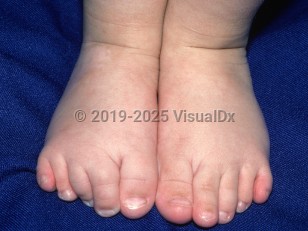Nager syndrome in Child
Alerts and Notices
Important News & Links
Synopsis

Nager syndrome (Nager acrofacial dysostosis syndrome) is a rare genetic condition of deformities of varying severity in the craniofacial skeleton, upper limbs, and hands. Caused in about 60% of cases by mutation in the SF3B4 gene. The majority of cases are sporadic, but autosomal dominant and autosomal recessive inheritance cases have been identified. Characteristic craniofacial abnormalities include malar, maxillary, and mandibular hypoplasia, macrostomia, micrognathia, midface retrusion, absent temporomandibular joint, cleft palate, malformed ears, microphthalmia, coloboma, downward-slanting eyes, and missing eyelashes. Due to these deformities, patients may experience poor feeding or develop life-threatening respiratory issues.
Abnormalities of the middle ear cause deafness in 60% of affected individuals. Limb and hand abnormalities may include hypoplasia of the radius and thumbs, triphalangeal thumbs, hypoplastic phalanges, syndactyly, clinodactyly, and rarely lower limb hypoplasia, overlapping toes, and clubfeet. Cognition is normal, but hearing loss may cause speech delays. In rare instances, other systemic abnormalities may present.
Abnormalities of the middle ear cause deafness in 60% of affected individuals. Limb and hand abnormalities may include hypoplasia of the radius and thumbs, triphalangeal thumbs, hypoplastic phalanges, syndactyly, clinodactyly, and rarely lower limb hypoplasia, overlapping toes, and clubfeet. Cognition is normal, but hearing loss may cause speech delays. In rare instances, other systemic abnormalities may present.
Codes
ICD10CM:
Q75.4 – Mandibulofacial dysostosis
SNOMEDCT:
35520007 – Nager syndrome
Q75.4 – Mandibulofacial dysostosis
SNOMEDCT:
35520007 – Nager syndrome
Best Tests
Subscription Required
References
Subscription Required
Last Updated:11/09/2023
Nager syndrome in Child

